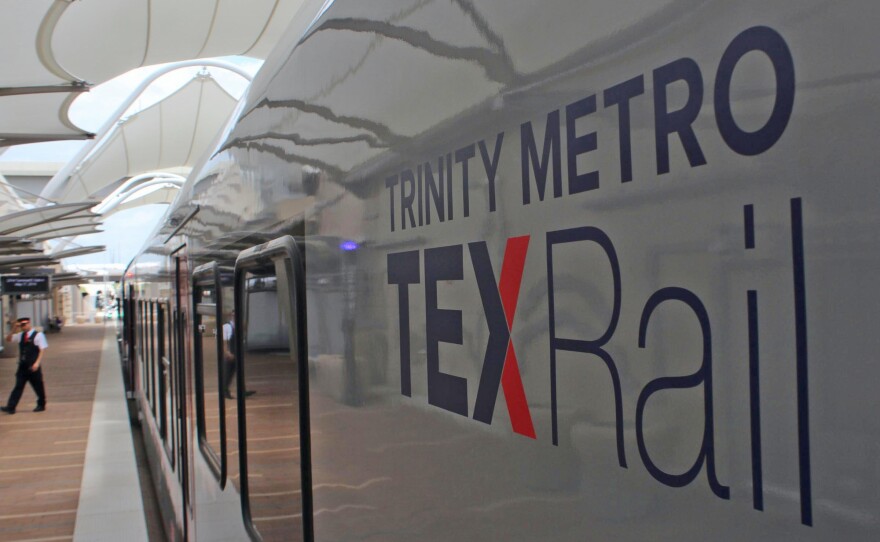TEXRail got off to a bit of a rocky start, delayed by the federal government shutdown. But four months after the train began running between central Fort Worth and Dallas-Fort Worth International Airport, riders say they’re happy with the service.
On Friday, Jon Rodriguez hopped on the train in downtown Fort Worth’s intermodal station, which is being rebranded as Fort Worth Central Station. He and his friend Mary Elia were headed to Grapevine for a street festival. Rodriguez, a chef who recently moved back to Fort Worth from Austin, says TEXRail was a pleasant surprise.
“It’s the last thing I expected when I came back,” Rodriguez says.
RELATED | TexRail Is Finally Here — Here's How It Works
More than 217,000 people have ridden TEXRail since it opened, though nearly half of them rode in early weeks when rides were free. It’s well short of the projected 8,000 average daily ridership, but Bob Baulsir, who runs the Trinity Metro transit agency, says he’s happy with the numbers.
These first few months, he says, have been about working out the kinks. Soon, he says, TEXRail will get an eighth train delivered, and this summer, the train’s frequency during rush hour will double.
“This is kind of, for lack of a better term, really the field testing: perfect it and get it good. But we’re there, we’re ready, and the last train set is on the way," he says.
A chance to ditch the car commute
Baulsir thinks ridership will increase with more frequent trains, and more and more people who work at jobs near TEXRail stops will re-think their daily drives, especially as Trinity Metro works to rejigger existing services to work better with the new train and add new options. At Mercantile Center, a new subsidized ride-sharing service branded ZIPZONE will be rolled out to take workers the last mile to the 18,000 jobs nearby.

There are also thousands of potential daily riders who work at the airport.
Noe Montez, who’s worked for American Airlines’ fleet services division for 38 years, says he happily gave up a congested daily commute by truck that ended with an unpredictable wait for the irregular employee shuttle at the airport. Now, he rides from North Fort Worth straight into Terminal B. He says the train is punctual, gives him a chance to chat with other riders and relax on his way to and from work, and it saves him money.
“I have a truck and I was filling it up three times a week and now I just have to fill it up one time, and I think that’s great,” Montez says.
An early impact
TEXRail’s impact actually started before the train was running, as developers started building around the train stations, like 800 new residential units in North Richland Hills and a new hotel in Grapevine. Baulsir says more than $300 million has been spent developing around the TEXRail stations.
“Where the trains stop, towns grow. It’s always been like that, right from the point that the Trans-Continental Railroad came in and all the West developed and everything else,” Baulsir says. “It’s like that with TEXRail. Not on such a grand scale, of course.”
What's next
Trinity Metro is looking to expand the TEXRail line southeast through Fort Worth, first to the hospital district and then, perhaps, a stop near Texas Christian University. Beyond the train, the transit agency is launching a free electric bus between Fort Worth’s museum district and downtown, and there’s talk of express busses along major commuter routes.
For Kam Phillips, on her way to the airport, it’s exciting to see more transit options in town.
“I grew up in Fort Worth, and I remember having to take the bus in High School, and that was something that no one did and it was frowned upon,” she says.
Phillips is 28, runs a non-profit and says the city needs to build a lot more public transit than it already has. Not only is it good for the environment, she says it would help the city’s residents who live in food deserts get groceries, and connect people to job opportunities.
And she thinks it’s an important investment for attracting college-educated Millennials and the businesses that want to hire them.
“It’s something Millennials think about when they look at how they want to live,” Phillips says. “My best friend is this cosmopolitan world traveler and I keep trying to get him to move to Fort Worth, and he’s like no, I will never live in a city that doesn’t have public transit or a robust public transportation infrastructure.”
Bob Baulsir thinks his transit agency can add more value to Fort Worth residents by coordinating resources more thoughtfully. Still, Fort Worth spends far less on public transit than any other big Texas city, and Baulsir says more funding will inevitably be part of the conversation.
“I think at some point, when you look at the population, you’re going to have to put more money into it,” he says. “But it would only be logical to look at it in a data-driven way, and do it right.”
Trinity Metro and the city of Fort Worth are studying ways to meet the public transit needs of its growing population. Three public meetings are scheduled later this week to get input from residents:
- May 22 at 5:30pm at the Central Library’s Chappell Room, 500 W. 3rd Street, in downtown Fort Worth.
- May 23 at noon at Central Station, 1001 Jones Street, 2nd Floor, in Fort Worth.
- May 23 at 5:30pm at Tarrant County College Opportunity Center, 5901 Fitzhugh Ave, Room 1440
Seemore information about the Fort Worth transit study here.









